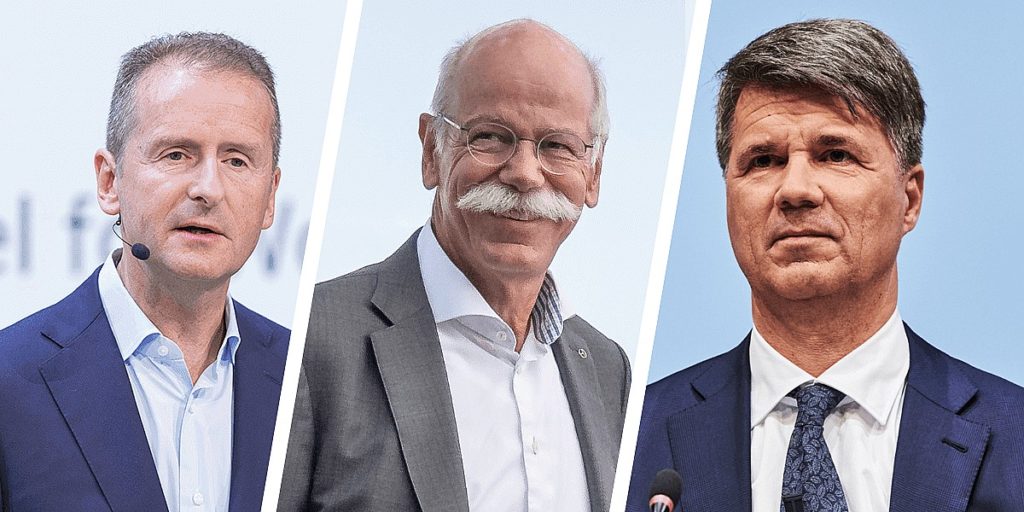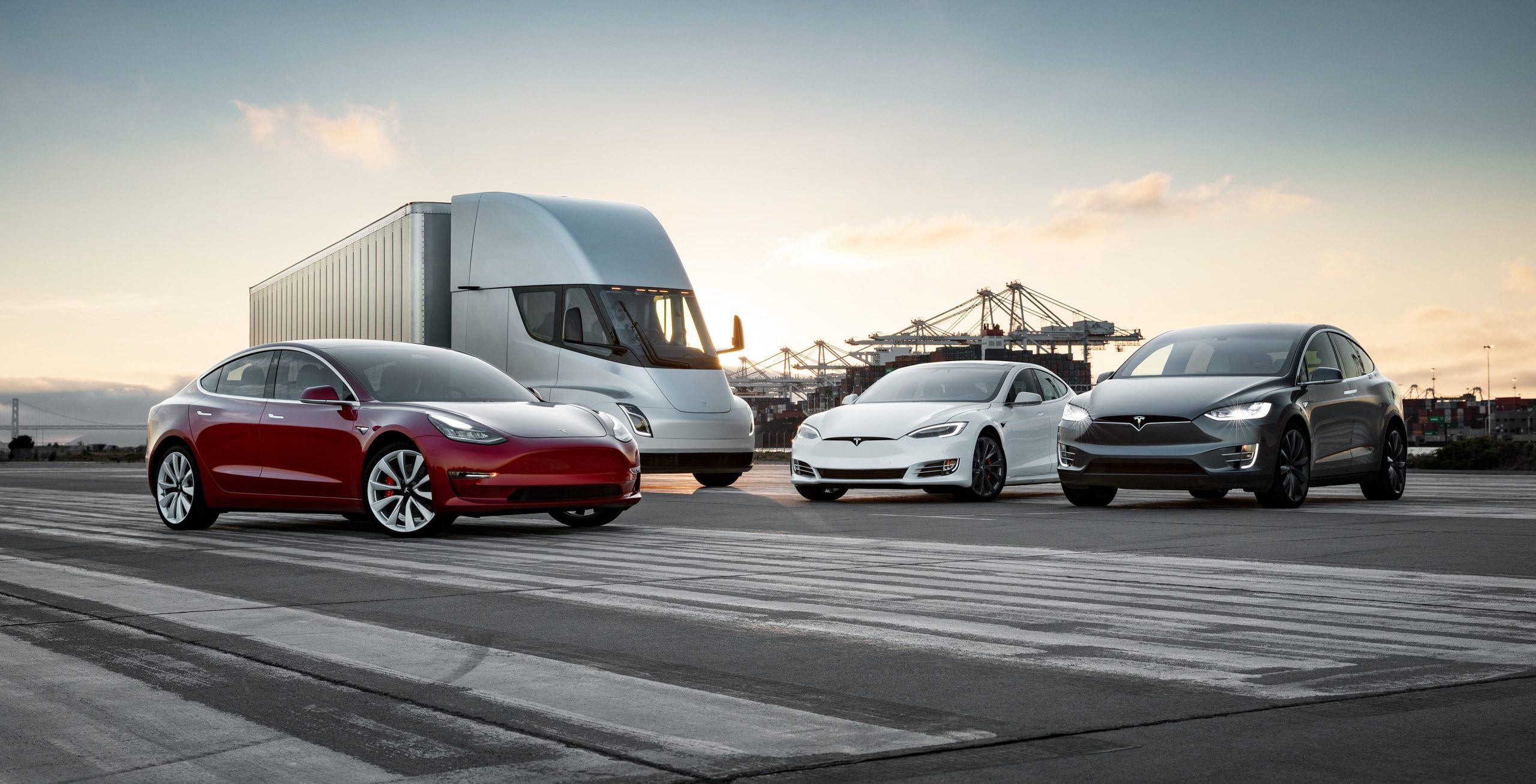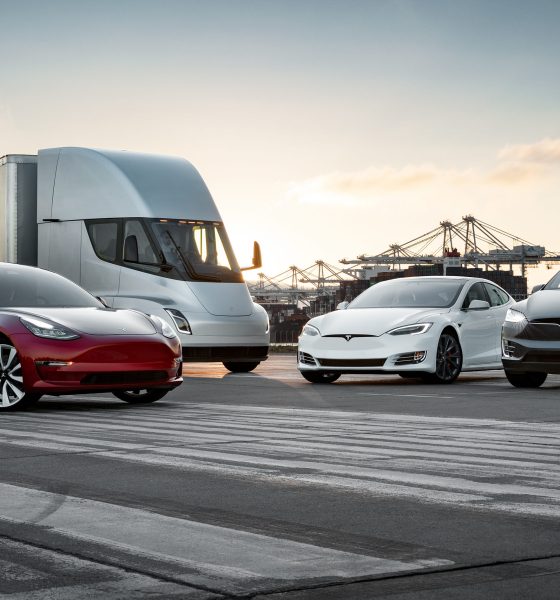The auto industry saw something historic happen this past week in Germany. In a rare act of unity, the leaders of the country’s big three Automakers; Volkswagen CEO Herbert Diess, Daimler CEO Dieter Zetsche, and BMW CEO Harald Krüger, all agreed that the future of German auto is the electric car. Over the next decade, each CEO would be pushing their respective companies to shift and embrace the idea of an electrified fleet.
No (more) compromises
The deal did not come easy. The Volkswagen CEO caused waves among German automakers and suppliers after he called for the widespread adoption of electric cars and a mass investment in EV charging infrastructure. The VW CEO’s proposal was bold: he wanted the German auto industry to focus solely on EVs, and he warned that he would be “evaporating billions” to do so. The proposal was met with a lot of criticism, from both fellow automakers and suppliers. In response, Volkswagen threatened to leave the industry lobby group Association of the Automotive Industry (VDA) because of its refusal to commit to an electric-first strategy.
BMW CEO Harald Krüger was particularly critical of Volkswagen’s proposal, which resulted in what industry insiders described as heated talks between the two executives. Krüger’s reservations are understandable, as Volkswagen’s demands do not favor BMW. One of Diess’ requests called for free charging benefits for electric car owners whose vehicles cost less than 20,000 euros. This benefits Volkswagen, which is aiming to produce an affordable electric car, but not companies like BMW and Daimler, who, on average, make more expensive vehicles.

Despite these headwinds, a short but meaningful call last Wednesday sealed the deal for Das Auto’s electric car initiatives. Insiders from news publication Handelsblatt noted that after ten minutes, the Volkswagen, BMW, and Daimler CEOs were practically on the same page, and by the end of the 40-minute conference call, the three executives have found a middle ground. The representative of the VDA dubbed the meeting as “constructive,” and the lobby group has stated that it’s expecting the three manufacturers to work out a consensus paper in the near future.
Apart from advocating for electromobility, The companies also decided to forego commitments to other forms of alternative propulsion, such as hydrogen fuel cells. In a statement to media publication welt.de, BMW member of the board Klaus Fröhlich mentioned that a breakthrough in hydrogen fuel cell cars is unlikely within the next decade, particularly as charging infrastructure for electric vehicles is growing at a rate where long-distance travel will soon be a non-issue. “The probability of a hydrogen infrastructure developing in parallel is very low,” Fröhlich said.
A LinkedIn post written by the Volkswagen CEO outlined his points as follows. “In order to stop global warming, there is no way around the Paris climate targets. To do this, the car must become cleaner as soon as possible and CO2-free by 2050 at the latest. E-mobility is the only technology that is feasible from today’s perspective. I am convinced that if we concentrate all our energies on the leading technology of electromobility, we will achieve both: the car will become cleaner in the short term and CO2-free in the long term. And the car country Germany will be the world leader in driving the future,” Diess wrote.
All According to the (Master) Plan

While Germany’s commitment to electromobility is undoubtedly impressive, it should be noted that the developments and milestones of the electric motor and electric car batteries over the past years are the catalysts that initiated this change. Electric mobility advocate Auke Hoekstra notes that electric motors are pretty much the only superior alternative to the internal combustion engine today, in the way that they are smaller, lighter, cheaper, practically maintenance-free, and around four times more efficient. It should also be noted that it took the efforts of a daring Silicon Valley electric car company to show the industry that electric mobility is feasible.
Elon Musk has always noted that Tesla exists to accelerate the world’s transition to sustainable energy. Back in 2006, he posted his first Master Plan, which involved the creation of electric cars that are so compelling for car buyers; the behemoth that is traditional auto will start shifting its efforts to electric mobility. Tesla’s first car, the original Roadster, was mostly a proof-of-concept in this sense, as it is a vehicle that simply proved the idea that electric cars can be just as fast, sexy, and desirable as the next Porsche or Ferrari. The Model S and Model X took the company’s mission further, proving that electric cars are not only comparable to their fossil fuel-powered counterparts; they could be far better. Loaded to the teeth with tech, the sedan and crossover (hence the Model “S” and “X” moniker) were successful, but they still only catered to the higher end of the market.
Tesla shook the auto industry with the Model 3, a vehicle that practically took the company and its CEO inches away from ruin. Elon Musk described the Model 3 ramp as one of the most painful periods of his career, and objectively speaking, he was correct. Musk bet Tesla’s entire future in the Model 3, and if it wasn’t for his own willingness to sacrifice his own comfort (Musk returned to sleeping under a table in Tesla’s Fremont factory at the height of the Model 3’s “production hell”), clever, out-of-the-box solutions from remarkable executives like current President of Automotive Jerome Guillen (who came up with the idea of creating another Model 3 assembly line inside a sprung structure), and the insane efforts of Tesla’s workers across the board, the company would have fallen. Months later, the Model 3 would become the United States’ best-selling luxury vehicle of 2018, and within the first quarter of 2019, the electric sedan would begin to take over Europe and China. At this point, it is no exaggeration to state that the Model 3, with its track-capable motors and battery, is pretty much the gold standard of electric vehicles today.
A Mission Achieved

With the behemoth that is German Auto now awakened and committing itself fully towards electric mobility, will Tesla finally be trampled under the giants’ feet? Not necessarily. Tesla still functions like a Silicon Valley startup, moving fast, making mistakes, and fixing errors on the go. The result of this work culture, coupled with extensive experience with the electric motor and batteries, is a carmaker that moves incredibly fast. Thus, by the time the German automakers come up with vehicles that can challenge the Model 3 in its current iteration in terms of tech, features, and specs, Tesla would probably have improved its vehicles further. It’s incredible to see traditional automakers finally commit to electric cars, but in terms of beating Tesla, it would suffice to say that it would be very difficult to trample a company that stubbornly refuses to stay still.
When asked by 60 Minutes host Lesley Stahl if he would be open to other carmakers beating Tesla at its own game, Elon Musk candidly stated that as long as the world’s shift to electric transportation is secured, he would be able to sleep well at night. “If somebody comes and makes a better electric car than Tesla and it’s so much better than ours that we can’t sell our cars, and we go bankrupt, I still think that’s a good thing for the world,” Musk said, to the surprise of the veteran host. This is one of the things that is fascinating about Tesla and Elon Musk. Both the company and its CEO are fighting tooth and nail every day to meet its next ridiculously difficult target; but beyond these struggles, Musk and Tesla are fully aware that the fight is much bigger than them. A future that is not dependent on fossil fuels is a far bigger cause.
It took a while before Germany’s biggest car conglomerates saw the writing on the wall. Now that they have, it would not be surprising at all if the auto industry does start a full embrace of electric mobility. China is already waist-deep in its EV initiatives, and with Germany doing the same, it would be difficult for the internal combustion engine to remain relevant in the decades to come. One could only hope that the United States’ big three, Ford, GM, and Fiat-Chrysler, will follow. Tesla is already based in the US, and its patents are open-sourced. At this point, the writing is now in big, bold letters, and it would be foolish to insist that electric mobility is “not yet ready” or “not feasible.” As for Tesla, one can only hope that the company had learned its lessons with the Model 3 as it attempts to produce the Model Y, an even more ambitious vehicle that will compete in one of the world’s most lucrative markets.

Elon Musk
Elon Musk’s Biggest Revelations on AI, Robots, and the Future of Work from the Moonshots Podcast

Elon Musk’s appearance on the Moonshots with Peter Diamandis podcast was packed with bold predictions, candid admissions, and surprising tech insights. The nearly three-hour conversation covered everything from artificial intelligence to humanoid robots, geopolitics, and the future of work. Here are the top 10 most intriguing takeaways:
-
Aggressive AGI Timeline Predictions
Musk offered a detailed view on when artificial general intelligence (AGI) could emerge, suggesting it may arrive sooner than many expect, emphasizing both transformative potential and risks.
-
U.S. vs. China in the AI Race
He discussed the strategic competition between the United States and China over AI development, noting that geopolitical dynamics will shape how and who leads in the next decades.
-
Future of Job Markets
Musk touched on how AI and automation could reshape employment, predicting massive boosts in productivity alongside potential disruptions in traditional work structures.
-
Clean Energy Transition
A recurring theme was the role of clean energy in future economies, with Musk reiterating the importance of scaling sustainable power generation and storage.
-
Humanoid Robots Are Coming
On the podcast, Musk elaborated on Tesla’s work on humanoid robots, hinting at timelines and applications that go beyond factories to general-purpose assistance.
-
Tesla Roadster “Last Human-Driven Car”
Outside the core discussion topics, Musk teased features of the upcoming Tesla Roadster — calling it “the best of the last of the human-driven cars” and suggesting safety won’t be its main selling point.
-
The Role of AI in Clean Energy and Robotics
Linking AI to both energy optimization and robotics, Musk explained how smarter systems could accelerate decarbonization and task automation across industries.
-
U.S. Innovation Leadership
Musk argued that maintaining American leadership in key tech sectors like AI, space, and robotics should be a national priority, with thoughtful policy and investment.
-
Job Creation vs. Job Elimination
While acknowledging automation’s disruptive effects, he also outlined scenarios where new industries and opportunities could emerge, particularly in AI, space, and advanced manufacturing.
-
Long-Term Vision for Humanity
Throughout the conversation, Musk revisited his long-term philosophical views — including a belief in humanity’s responsibility to become a multi-planetary and technologically empowered species.
Whether you agree with Musk’s optimism or not, the podcast offers a window into the thinking of one of the most influential figures in tech today, in and why his visions continue to spark debate and inspiration.
Elon Musk
Elon Musk just said some crazy stuff about the Tesla Roadster

Elon Musk appeared on the Moonshots podcast with Peter Diamandis today to discuss AGI, U.S. vs. China, Tesla, and some other interesting topics, but there was some discussion about the upcoming unveiling of the Roadster, the company’s electric supercar that will arrive several years after it was initially slated for release.
Musk made some pretty amazing claims about the Roadster; we already know it is supposed to be lightning-fast and could even hover, if Tesla gets everything to happen the way it wants to. However, the car has some pretty crazy capabilities, some of which have not even been revealed.
On the podcast, Musk said:
“This is not a…safety is not the main goal. If you buy a Ferrari, safety is not the number one goal. I say, if safety is your number one goal, do not buy the Roadster…We’ll aspire not to kill anyone in this car. It’ll be the best of the last of the human-driven cars. The best of the last.”
🚨 Elon on the Roadster unveiling, scheduled for April 1:
— TESLARATI (@Teslarati) January 6, 2026
Musk makes a good point: people who buy expensive sports cars with ridiculous top speeds and acceleration rates do not buy them to be safe. They hope they are safe in case of an emergency or crash, but safety is not at the forefront of their thoughts, because nobody buys a car thinking they’ll crash it.
The Roadster is truly going to push the limits and capabilities of passenger vehicles; there’s no doubt about that. Tesla plans to show off the new version car for the first time on April 1, and Musk has only hinted at what is possible with it.
Musk said back in November:
“Whether it’s good or bad, it will be unforgettable. My friend Peter Thiel once reflected that the future was supposed to have flying cars, but we don’t have flying cars. I think if Peter wants a flying car, he should be able to buy one…I think it has a shot at being the most memorable product unveiling ever. [It will be unveiled] hopefully before the end of the year. You know, we need to make sure that it works. This is some crazy technology in this car. Let’s just put it this way: if you took all the James Bond cars and combined them, it’s crazier than that.”
Production is set to begin between 12 and 18 months after the unveiling, which would put the car out sometime in 2027. Hopefully, Tesla is able to stay on track with the scheduling of the Roadster; many people have been waiting a long time for it.
News
Tesla launches hiring for Robotaxi program in its twentieth country
Overall, the hiring signals Tesla’s aggressive timeline for global dominance in autonomous mobility.

Tesla has launched a hiring initiative for its Robotaxi program in its twentieth country, as the company posted two new jobs in Thailand this week.
Tesla is hiring in Bangkok and Kowloon for the Vehicle Operator position, which is related to data collection, and is the first in Thailand, but the twentieth country overall, as the company tries to expand into other markets.
🚨 BREAKING: Tesla is hiring additional full-time Vehicle Operators in Bangkok, Thailand.
Previous openings were 6-month, part-time roles. These are equivalent to AI Safety Operator roles in the U.S. pic.twitter.com/R6LzoU1bos— Tesla Yoda (@teslayoda) January 5, 2026
Tesla has had active job postings for Vehicle Operator positions in the United States, India, Israel, Taiwan, Germany, the Czech Republic, Hungary, the UK, Finland, Switzerland, Sweden, the Netherlands, Austria, Spain, Norway, Italy, and Turkey in past listings.
These postings are not all currently available, likely because the roles have been filled.
Thailand is the most recent, and broadens the company’s potential path to expanding its ride-hailing program, which is only active in the United States in Austin, Texas, and the California Bay Area, so far.
These roles typically involve data collection, which assists in improving Autopilot and Full Self-Driving operation. Tesla’s self-driving programs utilize real-world data that is accumulated and stored, observing vehicle and traffic behavior, as well as tendencies that are performed by human drivers to help increase safety and overall performance.
Overall, the hiring signals Tesla’s aggressive timeline for global dominance in autonomous mobility. Although the company has several high-profile rivals and competitors in the field, it has established itself as a main player and a leader in the development of autonomous technology, especially in the U.S., as its FSD suite is refined on almost a weekly basis.
The Full Self-Driving suite is available in seven countries and territories currently, including the U.S., Canada, China, Mexico, Puerto Rico, Australia, and New Zealand. Its biggest goal for expansion is currently the European market, where regulatory hurdles have been the main bottleneck prolonging its launch on the continent.
Tesla has performed months of testing in various European countries, including France and Spain, and does have support in some areas from various regulatory agencies. However, the company is hoping to get through this red tape and offer its suite in Europe for the first time, hopefully this year.










